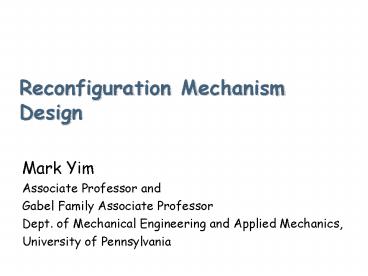Reconfiguration Mechanism Design PowerPoint PPT Presentation
1 / 26
Title: Reconfiguration Mechanism Design
1
Reconfiguration Mechanism Design
- Mark Yim
- Associate Professor and
- Gabel Family Associate Professor
- Dept. of Mechanical Engineering and Applied
Mechanics, - University of Pennsylvania
2
- There are two fundamental electro-mechanical
components to self-reconfiguring robot systems - An attaching/detaching mechanism
- Some form of motion between reconfigurations.
- Focus on hardware, however, choices in hardware
effect software design and vice versa.
3
Costs of micro-scale device(pessimistic view)
- Module 1mm x 1mm x 1mm MEMS (silicon)
- Silicon cost 1/sq inch
- 2003 Revenue 5.7billion / 4.78 billion sq inch
silicon - 200 / 12 diam, 30 /8 diam wafers
- 100um-2000um thick (choose 1mm)
- Assume processing costs 9/sq inch
- Modules cost 1.6
- Synthesize human shape
- Mark weighs 65 Kg -gt 65,000 cm3
- Assume density of water (1kg 1000 cm3 )
- 65,000,000 modules
- 1000 modules per cm3
- Cost 1,007,502.025
4
Costs of micro-scale device(optimistic view)
- In mature systems, cost goes by the pound.
- E.g. Xerox machines
- Optimization in space/volume
- The process cost can be reduced. Ultimately to
near the cost of silicon (factor of 10 savings) - Fill factor of modules does not need to be 100
(factor of 10 savings) - Find a smaller person to synthesize (factor of 2
savings) - Cost 5,037
5
Outline
- Review of Motion mechanisms
- Chain style reconfiguration
- Lattice style reconfiguration
- Review of Latching mechanisms
- Discussion
6
Three Classes of Existing Self-Reconfigurable
Robots
Mobile
Chain
Lattice
7
Telecube G1
Lattice Self-Reconfiguration
8
Proteo (never built)
Proteo
Rhombic Face (Edge length 5 cm)
9
- I-Cube, Cem Unsal _at_ CMU
- Metamorphic, Chirikjian _at_ Hopkins
10
Dartmouth
- Molecule Kotay Rus
- Crystal Vona Rus
11
Satoshi Murata (lattice)
- Fracta
- 3D fracta
12
- Molecube, Lipson _at_ cornell
- ATRON, Ostergaard, et. al _at_ U. S. Denmark
13
Inoue, Pnumatic
Riken, Vertical
14
Stochastic/Graph Grammars
- No main actuation (external)
- Klavins
- Lipson
- Latching
- Magnets
- Pressure differential in oil
15
Chain Self-ReconfigurationPolyBot Generation 2
(G2), and 3 (G3)
16
- Polypod
- UPenn superbot
17
- Conro, Shen/will _at_ ISI
- Mtran, Murata et al
18
Nilsson, Dragon
19
Lattice vs Chain
- 1 DOF motion docking
- Local self-collision detection
- Higher stiffness dock
- No singularities,
- No mechanical advantage
- Discrete motions
- GeneralManipulation difficult
- Unstructured environments difficult
- 6 DOF motion docking
- Global self-collision detection
- Lower stiffness dock
- Singularities
- Complicates control
- Arbitrary motions
Lattice is easier for self-reconfiguration Chain
is easier for locomotion/manipulation
20
Main drives
- Geared DC motors (most popular)
- Magnetic
- Pneumatic
- None
- Not shown yet
- Combustive easier if modules are large
- Thermal (nuclear?) perhaps in space
- Mechanochemical does this exist?
- Electrostatic ok if small? High voltages
- Molecular motors if very tiny
21
Latching mechanisms
- Magnetic issue strength
- Mechanical issue actuator (size
(strength/speed)) - Pneumatic issue valves, supply
- Hydraulic issue valves, supply
- Not shown yet
- Electrostatic ok if small? High voltages
- Dry Adhesive attach/detach motion?
22
Stolen from Esbed Ostergaard Thesis U. Southern
Denmark
23
Questions
- What are the important parameters for the motion
part? What are the tradeoffs? - DOF?
- Shape?
- of attachments
- Workspace?
- What are the important parameters for
attaching/detaching mechanisms?
24
(No Transcript)
25
What on earth are we going to do with these
robots?
- NASA program
- Its going to be more robust to send specialized
machine per task - Multifunction cost savings vs capability
- Space station repair
- Mars exploration
- Moon station (selfreplication)
- Construction
- Locomotion with manipulation
- E.g. mine sensor support w/shoring
- Building construction
- Architecture
- Exploration
- Search and rescue
- Undersea mining
- Planetary mining
- Shape only
- Structures
- Telepario
- Shady robots
26
- Shape vs function
- 3 people do shape only
- Fundamental assumptions(?)
- Self
- Organizing
- Reconfiguring
- Repairing
- Funding ?
- Communities to relate to?
- Complexity systems community
- Nanoscience community (foundations of
nanoscience) - Availability of low cost reliable hardware helps
to enable robotics research - Common platform, (e.g. mote like)
- Sources of funding?
- DARPA, NSF, Europe, (Brad has money)
- Japan Aist/TiTech last

